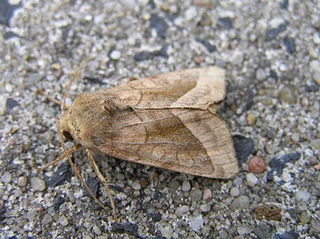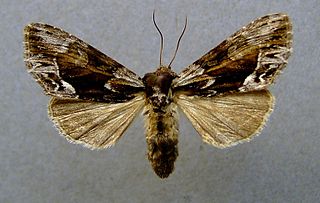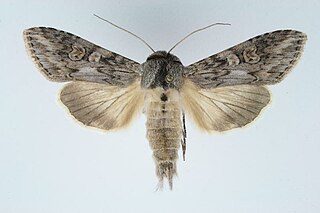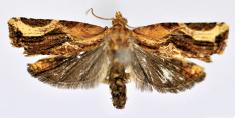
Apamea monoglypha, the dark arches, is a moth of the family Noctuidae. The species was first described by Johann Siegfried Hufnagel in 1766. It is a common, sometimes abundant, European species. It is found in most of Europe except northernmost Fennoscandia and the southern parts of the Iberian Peninsula and Greece. The species is also found in Anatolia, Turkestan, Western Asia and Central Asia, Siberia and Mongolia. In the Alps it is found up to heights of 2,500 meters. The smaller subspecies sardoa is found on Sardinia and Corsica.

Apamea crenata, known as the clouded-bordered brindle, is a moth in the family Noctuidae. It is distributed throughout the Palearctic realm. In the North it crosses the Arctic Circle, in the Mediterranean it is found only in cool locations and mountains avoiding very hot areas. In the Alps, it rises to an altitude of about 2000 metres.

Vindula erota, the common cruiser, is a species of nymphalid butterfly found in forested areas of tropical South Asia and Southeast Asia.

Filatima is a genus of moths in the family Gelechiidae.

Apamea ophiogramma, the double lobed, is a moth of the family Noctuidae. It is found in the Palearctic realm in North and Central Europe to the Urals, Turkestan, Russian Far East, and Siberia. There have been at least two separate introductions into North America and it is now rapidly expanding in range. This species is sometimes placed in the monotypic genus Lateroligia.

Lygephila pastinum, the blackneck, is a moth of the family Erebidae. The species was first described by Georg Friedrich Treitschke in 1826. It is found in Europe and across the Palearctic Siberia, the Russian Far East, Japan and China.

Hydraecia micacea, the rosy rustic, is a moth of the family Noctuoidea. It is found across the Palearctic realm from Ireland to Siberia. It reaches Japan and is introduced to eastern USA, Quebec and Ottawa.

Catocala electa, the rosy underwing, is a moth of the family Erebidae. The species was first described by Karl Friedrich Vieweg in 1790. It can be found in Europe and Asia.

Mesapamea secalis, the common rustic, is a moth of the family Noctuidae. The species was first described by Carl Linnaeus in his 1758 10th edition of Systema Naturae. It is found in Europe, north-west Africa, Turkey and northern Iran.

Agrotis trux, the crescent dart, is a moth of the family Noctuidae. The species was first described by Jacob Hübner in 1824. It has a circum-Mediterranean distribution and is found along the coasts of France, Ireland, England, southern Europe, Algeria, Syria, Iraq, Iran, southern Russia and the Arabian Peninsula. In Africa, it is found as far south as South Africa.

Hyppa rectilinea, the Saxon, is a moth of the family Noctuidae. It is found in Europe, but mostly in northern and central Europe. In the south, it is found in scattered populations, mainly in mountainous areas. To the east, its range stretches through northern Asia and eastern Siberia, up to the Pacific Ocean and Japan.

Apamea oblonga, the crescent striped, is a moth of the family Noctuidae. The species was first described by Adrian Hardy Haworth in 1809. It is found in northern and central Europe, east to southern Russia, Asia Minor, Armenia, Turkestan, Turkey, Iran, southern Siberia, northern Pakistan, Mongolia, China, Sakhalin and Japan

Cucullia artemisiae, or scarce wormwood, is a moth of the family Noctuidae. The species was first described by Johann Siegfried Hufnagel in 1766. It is found from central and southern Europe to Turkey and across the Palearctic to western Siberia, Central Asia, Manchuria, the Korean Peninsula and Japan.

Isodemis stenotera is a moth of the family Tortricidae. It is known from China and Indonesia (Sumatra).

The Beautiful Gothic(Leucochlaena oditis) is a Palearctic moth of the family Noctuidae, sub-family Cuculliinae. It is found in southern Europe and north Africa, with occasional finds on the southern coast of England.
Filatima albipectus is a moth of the family Gelechiidae. It is found in Mexico (Sonora) and the United States, where it has been recorded from California.
Filatima isocrossa is a moth of the family Gelechiidae. It is found in North America, where it has been recorded from Texas.
Filatima lapidescens is a moth of the family Gelechiidae. It is found in Mexico (Sonora).
Filatima natalis is a moth of the family Gelechiidae. It is found in North America, where it has been recorded from Arizona, Colorado and Oregon.

Filatima pseudacaciella, the dusky-backed filatima moth, is a moth of the family Gelechiidae. It is found in North America, where it has been recorded from California, Illinois, Indiana, Kansas, Kentucky, Louisiana, Maine, Massachusetts, Mississippi, New Hampshire, New York, Ohio, Oklahoma, Ontario, Tennessee and West Virginia.














